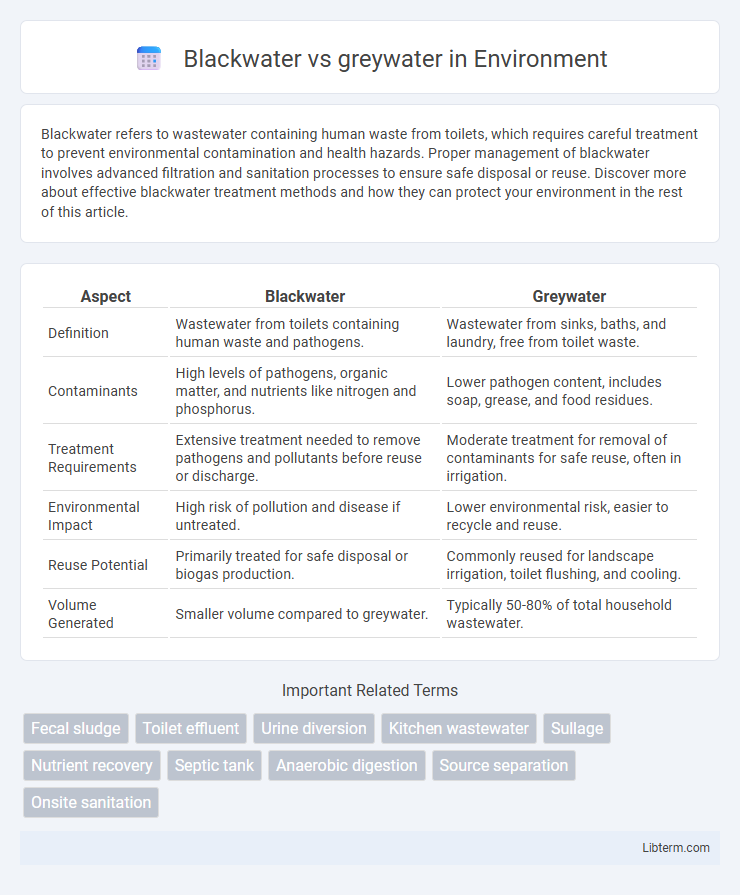Blackwater refers to wastewater containing human waste from toilets, which requires careful treatment to prevent environmental contamination and health hazards. Proper management of blackwater involves advanced filtration and sanitation processes to ensure safe disposal or reuse. Discover more about effective blackwater treatment methods and how they can protect your environment in the rest of this article.
Table of Comparison
| Aspect | Blackwater | Greywater |
|---|---|---|
| Definition | Wastewater from toilets containing human waste and pathogens. | Wastewater from sinks, baths, and laundry, free from toilet waste. |
| Contaminants | High levels of pathogens, organic matter, and nutrients like nitrogen and phosphorus. | Lower pathogen content, includes soap, grease, and food residues. |
| Treatment Requirements | Extensive treatment needed to remove pathogens and pollutants before reuse or discharge. | Moderate treatment for removal of contaminants for safe reuse, often in irrigation. |
| Environmental Impact | High risk of pollution and disease if untreated. | Lower environmental risk, easier to recycle and reuse. |
| Reuse Potential | Primarily treated for safe disposal or biogas production. | Commonly reused for landscape irrigation, toilet flushing, and cooling. |
| Volume Generated | Smaller volume compared to greywater. | Typically 50-80% of total household wastewater. |
Introduction to Blackwater and Greywater
Blackwater refers to wastewater containing human waste, typically sourced from toilets and containing pathogens, organic matter, and chemicals requiring careful treatment. Greywater originates from household activities like bathing, laundry, and dishwashing, characterized by lower contamination levels and easier treatment processes. Understanding the differences between blackwater and greywater is crucial for effective wastewater management, treatment, and potential reuse applications.
Key Differences Between Blackwater and Greywater
Blackwater contains wastewater from toilets and is heavily contaminated with pathogens and organic waste, requiring advanced treatment for safe disposal. Greywater originates from sinks, showers, and laundry, containing fewer harmful substances and is often suitable for reuse in irrigation and flushing after minimal treatment. The primary distinction lies in contamination levels and treatment requirements, with blackwater demanding stringent handling compared to the relatively safer greywater.
Sources of Blackwater in Residential Settings
Blackwater in residential settings primarily originates from toilets and kitchen sinks, containing high levels of organic waste, pathogens, and chemicals. It differs from greywater, which comes from showers, baths, and laundry, containing fewer contaminants. Proper treatment of blackwater is essential to prevent environmental pollution and health hazards.
Common Sources of Greywater at Home
Common sources of greywater at home include water from bathroom sinks, showers, bathtubs, and laundry machines. Kitchen sink water is typically excluded due to contamination with food particles and grease, making it less suitable for greywater reuse. Proper identification of greywater sources is essential for effective water recycling and reducing household wastewater impact.
Health and Environmental Impacts
Blackwater contains human waste and pathogens, posing significant health risks such as waterborne diseases if not properly treated, while greywater, being from sources like sinks and showers, has lower pathogen levels but may still carry contaminants like soaps and chemicals that can affect soil and water quality. Untreated blackwater can contaminate groundwater and surface water, leading to environmental degradation and biodiversity loss; greywater, when reused or disposed of correctly, reduces freshwater demand but can cause nutrient imbalances or toxicity if mismanaged. Effective treatment and management of both blackwater and greywater are crucial to minimize public health hazards and protect aquatic ecosystems from pollution.
Treatment Methods for Blackwater
Blackwater treatment involves advanced processes such as biological treatment, sedimentation, and disinfection to remove pathogens, organic matter, and contaminants effectively. Technologies like activated sludge systems, membrane bioreactors, and anaerobic digestion are commonly employed to treat blackwater, enabling safe reuse or discharge. Proper treatment ensures compliance with environmental regulations and prevents health hazards associated with untreated sewage.
Greywater Reuse and Recycling Options
Greywater reuse and recycling options offer sustainable solutions for reducing freshwater consumption by treating wastewater from baths, sinks, and washing machines for non-potable uses such as irrigation and toilet flushing. Advanced filtration and biological treatment systems improve greywater quality, enabling safe reuse while minimizing environmental impact and lowering utility costs. Implementing greywater recycling supports water conservation in residential, commercial, and industrial settings, enhancing resource efficiency and contributing to sustainable water management practices.
Legal Regulations and Guidelines
Blackwater and greywater are subject to distinct legal regulations due to their differing contamination levels; blackwater, containing human waste, is regulated more strictly under sanitary wastewater laws to prevent health hazards. Greywater, comprising wastewater from sinks, showers, and laundry, often falls under more lenient local codes allowing reuse for irrigation or toilet flushing, but requires treatment standards to avoid environmental contamination. Compliance with regional guidelines from agencies like the EPA or local health departments is essential for proper management and recycling of both water types.
Sustainable Water Management Practices
Blackwater, containing human waste and wastewater from toilets, requires advanced treatment methods to prevent environmental contamination, while greywater, sourced from sinks, showers, and laundry, is easier to recycle for irrigation and non-potable uses. Sustainable water management practices prioritize greywater recycling to reduce freshwater demand and minimize wastewater discharge, promoting water conservation in residential and commercial settings. Implementing onsite greywater systems alongside robust blackwater treatment technologies enhances resource recovery, reduces pollution, and supports circular water economy goals.
Future Trends in Wastewater Solutions
Innovations in wastewater management are increasingly distinguishing between blackwater and greywater to optimize treatment and reuse strategies. Advanced membrane bioreactors and decentralized treatment systems enable efficient recycling of greywater for agricultural and industrial applications, reducing freshwater demand. Emerging smart monitoring technologies enhance blackwater processing by improving pathogen removal and nutrient recovery, supporting sustainable urban water cycles.
Blackwater Infographic

 libterm.com
libterm.com